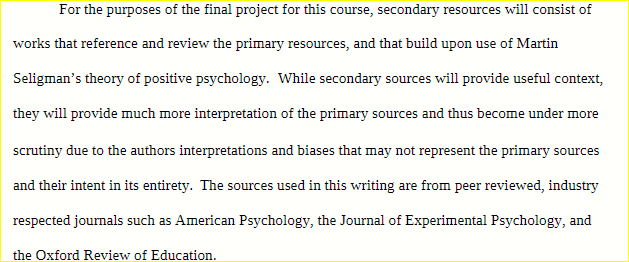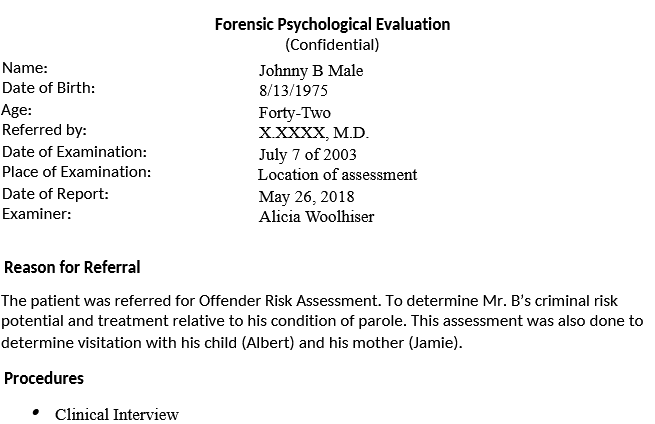PSY640 PSY 640 Module Two Journal A. Crosby.docx – Snhu
$3.99
PSY640 PSY 640 Module Two Journal A. Crosby.docx – Snhu
Evaluation of Research sources for the purposes of the final project for this course, secondary resources will consist of works that reference and review the primary resources, and that build upon the use of MartinSeligman’s theory of positive psychology. While secondary sources will provide useful context, they will provide much more interpretation of the primary sources and thus become under more scrutiny due to the author’s interpretations and biases that may not represent the primary sources and their intent in their entirety. The sources used in this writing are from peer-reviewed, industry-respected journals such as American Psychology, the Journal of Experimental Psychology, and the Oxford Review of Education. Historical ContextSteven Maier and Martin Seligman began to develop the theory of Learned Helplessness in 1967 by using behavior observation to study dogs, rats, and college students reacting.
Description
PSY640 PSY 640 Module Two Journal A. Crosby.docx – Snhu
Evaluation of Research sources for the purposes of the final project for this course, secondary resources will consist of works that reference and review the primary resources, and that build upon the use of MartinSeligman’s theory of positive psychology. While secondary sources will provide useful context, they will provide much more interpretation of the primary sources and thus become under more scrutiny due to the author’s interpretations and biases that may not represent the primary sources and their intent in their entirety. The sources used in this writing are from peer-reviewed, industry-respected journals such as American Psychology, the Journal of Experimental Psychology, and the Oxford Review of Education. Historical ContextSteven Maier and Martin Seligman began to develop the theory of Learned Helplessness in 1967 by using behavior observation to study dogs, rats, and college students reacting.
PSY640 PSY 640 Module Two Journal A. Crosby.docx – Snhu
Evaluation of Research SourcesThe sources I have selected for this research involves Martin Seligman’s theories of learned helplessness. The first source, Learned Helplessness in Humans: Critique and reformulation(Abramson, Seligman, & Teasdale 1978), examines learned helplessness theory and critiques two flaws with the previously-established research in this theory: (a) how uncontrollable situations are not uncontrollable for all individuals and (b) it does not specify when helplessness is chronic, specific or acute. This source both supports and contradicts the theory of learned helplessness. It supports it by specifying the aspects of established research that can be repeated and it contradicts the theory by exploring the fact that the theory was built upon data that is subjective depending on the situation of each client and the fact that its hypothesis was formulated before the experiments were performed on human subjects.
PSY640 PSY 640 Module Two Journal A. Crosby.docx – Snhu
A majority of the found sources support the selected theory of positive psychology. Some sources are directly written by Dr. Martin Seligman, providing direct insight regarding positive psychology, and findings. Other secondary sources evaluate the theories from Seligman and incorporate findings into various settings related to personality development and traits. Only a few of the sources have presented the needed criteria. More experimental-based articles must be found to further explore contemporary relevance to other personality theories. This will allow further understanding of the validity of the main points from Seligman’s theory. Historical ContextWhen Martin Seligman became elected as the president of the American psychological association in 1998, positive psychology was launched as a scientific study. Positive psychology also became relevant to Mihaly.
PSY640 PSY 640 Module Two Journal A. Crosby.docx – Snhu
- PSY 211 – Lifespan Development (5015 Documents),
- PSY 215 – Abnormal Psychology (4335 Documents),
- PSY 108 – Introduction to Psychology (3759 Documents),
- PSY 223 – Statistics for Psychology Research (2652 Documents),
- PSY 216 – Psychology of Personality (1841 Documents),
- PSY 510 – Research Methods (1748 Documents),
- PSY 520 – Research Methods in Psychology II (1469 Documents),
- PSY 257 – Psychology (1451 Documents),
- PSY 310 – Criminal Psychology (1393 Documents),
- PSY 200 – FOUNDATIONS OF ADDICTIONS (1379 Documents),
Only logged in customers who have purchased this product may leave a review.







Reviews
There are no reviews yet.